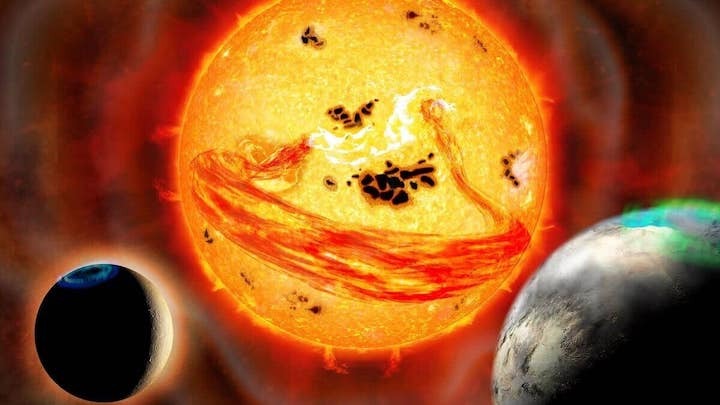14.12.2021
Superflare may hold the answer to one of our own solar system’s great unknowns.

Artist’s impression of a supermassive filament released by a superflare on EK Draconis approaching young planets. Credit: NAOJ
Astronomers spying on a nearby stellar system have observed a massive burst of energy and charged particles, known as a coronal mass ejection (CME), bigger than anything we’ve ever seen – and it hints at how volatile our own early solar system might have been.
The offending star, known as EK Draconis, burns dozens of light-years from Earth – relatively close in cosmic terms. It’s much younger than our sun, though, at 100 million years.
“It’s what our sun looked like 4.5 billion years ago,” says astrophysicist Yuta Notsu of the University of Colorado, US, co-author of a study published this week in the journal Nature Astronomy that describes the apocalyptic event.
The researchers set their sights on EK Draconis because they wanted to know whether these events are more common and more volatile in younger stars. They observed the star for 32 nights in winter and spring 2020 using NASA’s Transiting Exoplanet Survey Satellite (TESS) and Kyoto University’s SEIMEI Telescope. On 5 April, the research team was treated to a cosmic light show, as the star burst into a superflare. About 30 minutes after this initial observation, the team saw a CME erupt from the star’s surface, and a monster one at that, travelling at roughly 1.6 million kilometres an hour.
CMEs can be bad news. These clouds of hot particles or plasma can hurtle through space at breakneck speed, and should they encounter an unsuspecting planet that depends on electrical systems, those systems will likely fry. In fact, a suspected CME hit earth in September 1859 in what was later known as the Carrington Event. The event caused sparking and fires in telegraph systems and, if repeated today, would lead to widespread electrical disruption and blackouts.
“Coronal mass ejections can have a serious impact on Earth and human society,” says Notsu.
So, what are the chances of Earth being hit with an event as dramatic as the one from EK Draconis?
The study suggests that the April 2020 EK Draconis CME was more than 10 times larger than the most powerful ejection ever recorded from a star like our sun, but that doesn’t mean it couldn’t happen in our neck of the woods.
“This kind of big mass ejection could, theoretically, also occur on our sun,” says Notsu.
CMEs happen when a star lets out a flare, or a sudden burst of radiation. But such a massive superflare, while theoretically possible in a star such as our sun, would likely be a rare, once-in-several-millennia event. In fact, Notsu’s previous research suggests such superflares are much less common among older stars.
Instead, Notsu explains, the event provides a potentially telling window into the early years of our solar system’s existence: “This observation may help us to better understand how similar events may have affected Earth and even Mars over billions of years.”
In fact, giant CMEs may have helped shape planets like Earth and Mars. They may even hold the answer to one of astronomy’s most compelling questions.
“The atmosphere of present-day Mars is very thin compared to Earth’s,” says Notsu. “In the past, we think that Mars had a much thicker atmosphere. Coronal mass ejections may help us to understand what happened to the planet over billions of years.”
Quelle: COSMOS
